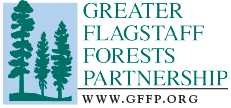 Background:
Background:
In November 2012, City voters overwhelmingly approved (74%) the $10 million-dollar Flagstaff Watershed Protection Project (FWPP). This forest treatment effort, involving city, state, and federal lands, is designed to reduce the risk of severe wildfire and subsequent post-fire flooding in the Rio de Flag (Dry Lake Hills) and Upper Lake Mary (Mormon Mountain) watersheds. FWPP is also designed to enhance ecological conditions, protect the watersheds, and provide social and economic benefits to the community.
“Flagstaff Watershed Protection Project: – Creating Solutions Through Community Partnerships”
The purpose of this white paper is to convey to other communities, municipalities, and/or government agencies the administrative functions and mechanisms used by the two primary partners, the City of Flagstaff (City) and the U.S. Forest Service, to develop and implement FWPP. The paper is designed as a case study for other entities considering a similar initiative. This case study spans the first two years of the project, from the bond election in November 2012 to December 2014. The value of this case study is two-fold. First, it is an historical account of what led to the successful passage and start-up of the FWPP. Second, it serves as a guide to the steps and the mechanisms used to develop and implement a successful private/public/agency partnership. These findings can be used as a foundation to develop a similar initiative designed to achieve community protection through forest management. For full report, see: FWPP – Creating Solutions Through Community Partnerships
GFFP’s Role:
GFFP works with partners on various aspects within the FWPP in four broad areas: public engagement, monitoring, financial leverage and project management.
Monitoring:
GFFP completed the City’s FWPP Monitoring Plan. An update to this Plan has recently been completed and will be posted here soon. Collectively, these efforts assist in conducting monitoring projects that better determine FWPP effectiveness. Based on monitoring results, application of lessons learned promotes enhanced economic, social and ecological outcomes and programmatic sustainability.
As FWPP has evolved, the City’s Monitoring Plan will track or monitor relevant outcomes throughout the 10 years of the project. Key monitoring questions have been developed in four broad categories that include:
Fire Behavior
Hydrologic Response
Socioeconomic
Other Ongoing/Potential Monitoring Projects


